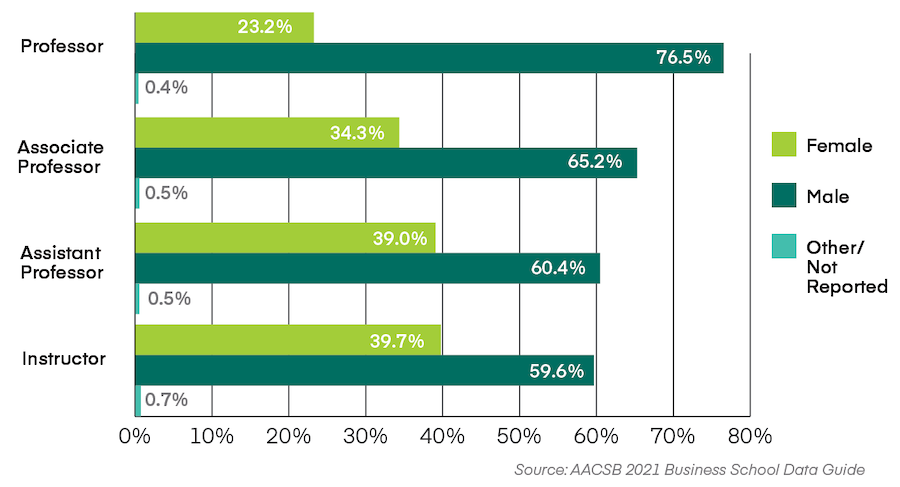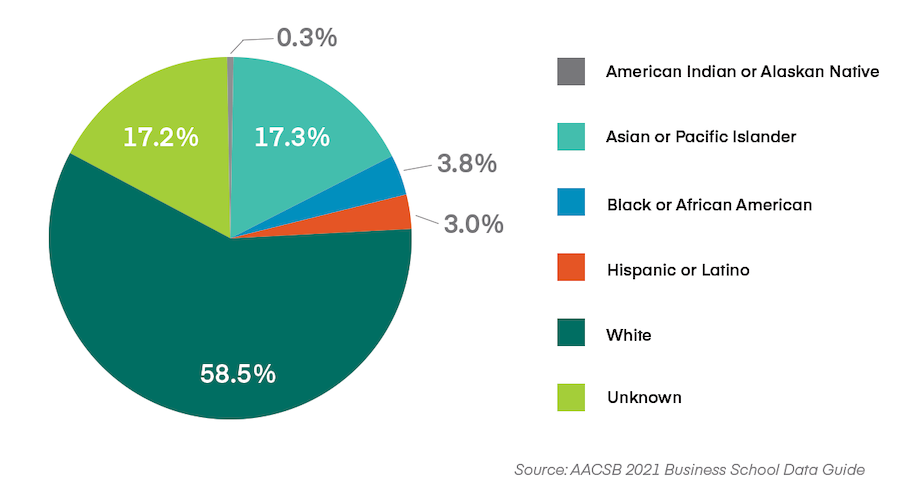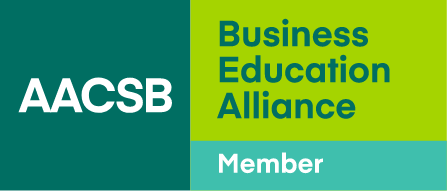Myths of the Diversity Dilemma
Business schools are not doing a good job of hiring individuals who reflect the diversity found not only in society, but also in our student populations.
For instance, according to the 2021 AACSB Business School Data Guide, just 33.8 percent of full-time faculty with doctoral degrees are women. Women’s representation in the faculty ranks decreases with every step up the career ladder, dropping from 39.7 percent of instructors to 23.2 percent of professors (see Figure 1).
Figure 1: Faculty Headcounts by Gender

The record is even more dismal when it comes to faculty who are Black and indigenous people of color (BIPOC). In the U.S., just 9 percent of female faculty are American Indian, Asian/Pacific Islander, Black, or Hispanic. The figures aren’t much better when they reflect both male and female faculty, as illustrated by Figure 2, which shows demographics for full-time faculty in the U.S. These low numbers are particularly troubling given research demonstrating that when BIPOC students have high-quality relationships with diverse faculty members, they benefit in terms of well-being, performance, and persistence.
Figure 2: Demographics for Full-Time Faculty in the U.S.

Business schools have long recognized, or at least given lip service to, the persistent problem of homogeneity among faculty and leaders of business schools. The problem took on new urgency in 2020, when communities were shaken into action by social unrest arising from racial injustice. Since then, scores of business schools have assembled task forces; created strategic plans to address diversity and inclusion; and designated leaders of diversity and inclusion initiatives.
However, business schools often remain unwilling to make strategic investments in diversity initiatives, such as cluster hiring to reduce the isolation of minority faculty. Nor have many made procedural changes, such as counting diversity and inclusion service toward promotion.
Misinformation as to the scope of this problem and our ability to address it abounds in business schools. In the minds of decision makers and in the discussions of hiring committees, certain myths about underrepresented groups are considered facts. While some of these attitudes might be rooted in racism and sexism, psychology offers additional insights into why these myths are perpetuated.
For example, humans are cognitive misers. Rather than investigate a particular problem for themselves, they often default to the beliefs of powerful, well-connected, or charismatic people, whether or not those beliefs are accurate. When it comes to reappointment, promotion, and tenure (RPT) decisions, these powerful people occupy positions on hiring committees and in deans’ suites.
To dispel some common myths, we present the following evidence-based truths. We hope these counterarguments will allow champions of change to help their schools create more diverse workforces on their own campuses.
Common Misperceptions
Four myths tend to flourish among university administrators:
Myth 1: “We already have diversity.”
Truth: Even if the directories of North American business schools didn’t offer visible proof that these schools lack women and BIPOC faculty members, the lack is also well-documented. However, schools should not focus on just improving their numbers. They also should create diversity and equality systems to leverage the unique talents of their faculty members.
Myth 2: “It’s just a pipeline problem.”
Truth: Researchers and laypersons alike have blamed a sluggish pipeline for persistent homogeneity. This excuse typically follows the same pattern: “We would hire more [insert underrepresented group of interest] if we could find them, but there simply are not enough of them.”
While this argument might have held some truth a generation ago when it was first presented, there are now ample solutions to the so-called pipeline problem. Thanks to organizations like The PhD Project, more underrepresented minorities are earning doctoral degrees in business fields. Furthermore, statistics from the National Science Foundation in the U.S. show that 41 percent of doctorates in business and management are awarded to women, and 69 percent are awarded to nonwhites. While business schools can and should do more to enrich the pipelines, administrators can no longer point to a lack of availability as an excuse not to hire more diverse faculty.
When women of color are required to adjust their style to that of the majority group, don’t receive high-visibility assignments, are not credited for their invisible labor supporting DEI initiatives, and don’t have high-influence mentors, they leave.
Administrators also should create more and different forms of support to ensure that existing female and BIPOC faculty remain in the field. When women of color are required to adjust their style to that of the majority group, don’t receive high-visibility assignments, are not credited for their invisible labor supporting diversity initiatives, and don’t have high-influence mentors, they leave. For these reasons, business schools should do more than root out well-known biases in promotion and hiring practices. They also should proactively design practices that support marginalized faculty members.
Myth 3: “There aren’t enough women/people of color who are qualified.”
Truth: This is a justification we have heard often in hiring discussions. However, research points to a different problem: Systematic biases interfere with perceptions of identical candidates, who differ only in their demographic categories. In fact, during the screening process, applicants from underrepresented ethnic groups have to complete 50 percent more applications to get job interviews than do equally qualified majority group candidates. For example, some interviewers put aside the applications of those with “ethnic-sounding” names.
As for the perception that underrepresented candidates lack track records of successful accomplishments, it might reflect the fact that diverse persons often are placed in tough, even untenable positions. For instance, “glass cliff” research shows that women are appointed to positions with a greater risk of failure, such as leadership of poorly performing work units.
Myth 4: “We don’t have the budget.”
Truth: Another myth is that because women and BIPOC applicants are relatively rare at business schools, they must command higher salaries than members of majority groups. But data from six disciplinary fields at 40 selective U.S. public universities show little evidence of a salary premium for diverse faculty members. In fact, those data evidence a racioethnic wage gap—not a premium—between the salaries of underrepresented faculty and white faculty.
Strategies for Creating Positive Change
In addition to myth-busting the stories people tell themselves about hiring diverse others, we’ve put together a list of five broad, actionable strategies school leaders can use to create positive change:
Model inclusive norms. For many reasons, majority group members might shy away from championing diversity in their organizations. For example, they might wonder, “Do I know enough to speak?” or “Is this really my issue?” However, allyship between majority and minority group members is a positive force for change. In particular, white male leaders—with the right intentions—can be especially successful at increasing diversity.
Because the group dynamics of hiring committees exert a collective influence on hiring outcomes, the culture of the business school matters, too. It’s not enough for the school to have a policy on the importance of diversity. Other factors that contribute to the diversity climate are the values that individuals hold and the presence of underrepresented groups in the unit.
Chances are, the information you need to make good, evidence-based decisions about the hiring of underrepresented groups can be found right down the hall.
Listen to your experts. Your own professors probably are underutilized in your school’s effort to create a more equitable faculty. Almost all business schools have experts in organizational behavior, and most have scholars focused on diversity and inclusion, yet administrators often look externally for diversity expertise. This is true even though external organizations frequently ask your faculty members to provide keynote addresses, training, and consulting. Chances are, the information you need to make good, evidence-based decisions about the hiring of underrepresented groups can be found right down the hall.
Mandate diverse slates of candidates. If your human resource management professionals provide you with homogeneous slates of applicants, push back. Ask them to cast a wider net. Or investigate whether the initial screening process was impeded by biases or non bona fide occupational qualifications.
Be aware that you won’t see real change if you screen only one candidate from an underrepresented group. Research suggests that if there is just one female or minority applicant, that individual is unlikely to get the job. Candidates can be seen on their own merits only when they are not viewed as token representatives of particular groups.
Implement targeted recruitment. You probably can’t rely on your usual hiring processes. But dozens of organizations and associations, even reputable Facebook groups, specifically target their outreach to women and BIPOC faculty, and you can post job openings on these sites.
In addition, you could encourage individual departments to consider applicants from related and potentially more diverse disciplines. For example, the proportion of women and BIPOC doctorates in psychology—a parent discipline to marketing and management—is greater than the proportion of similar people coming out of business doctoral programs. Recruiting from these sources could improve a business school’s access to diverse new faculty.
Value diverse areas of and approaches to teaching, service, and scholarship. For too long, business schools have prized a single-minded focus on a particular type of knowledge and particular measures of success. But students today demand greater practical preparation for working and thriving in global and diverse organizations. Faculty of color provide more social benefits crucial to learning, and they also support students in ways that are not always rewarded in traditional performance management systems.
Greater Impact
AACSB is committed to encouraging business schools to deliver pedagogy and research that has societal impact. We submit that one way business schools can widen and deepen their impact is by diversifying their faculty ranks.
It is time for business school leaders to refute the myths that implicitly and explicitly constrain hiring practices. It is time for them to become champions of evidence-based change.
This article was written on behalf of the Gender and Diversity in Organizations division of the Academy of Management.






